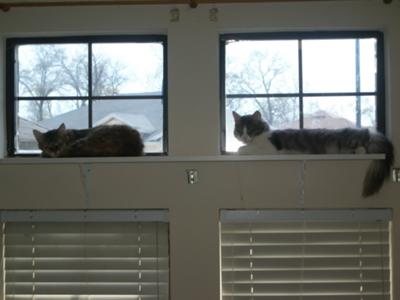In multi-cat households most cat guardians will be very reluctant to admit defeat when one of their cats hates another in the home. It may be the case that whatever they do they cannot achieve harmony between them and so must consider re-homing one of the cats. Jackson Galaxy in his book Total Cat Mojo provides pragmatic advice on the subject.

I hate your face
A major aspect of Jackson Galaxy’s advice on subjects like this is that he’s probably the most experienced person in America on issues of cat behaviour in multi-cat households. I am sure that he’s seen it all. Bearing in mind his confidence and knowledge I’m sure that on almost every occasion he believes that he can resolve the problem and get the cats to at least tolerate each other.
However, he freely admits that on some occasions he has to admit defeat and consider advising re-homing. It is the reality of the situation he says. He tells us that he’s worked in so many multi-cat homes where he has done everything to make “positive associations between two animals”. But no matter what he has tried as soon as they had access to each other the fur started to fly. He calls this condition, “I hate your face”.
Cat provides his viewpoint via behavior
He makes a very valid point. People sometimes don’t get along no matter what. It doesn’t matter if they are both well-behaved and decent people. It doesn’t matter if both of them behave reasonably towards each other. It’s just that they can’t get along and you have to respect their decision if they need to keep apart. Likewise cat owners should respect the decision of the domestic cat when he or she tells us through his behaviour that he hates the face of the other cat.

Last resort – review strategies
Re-homing is obviously a very last resort and he says that cat owners should tick the remedy boxes to make sure that they’ve done all they can before making a final decision. He refers to the “site-swap solution”. I believe that he is referring to keeping the cats apart by managing their territory. The concept is to keep them apart and therefore keep them together in a home. He refers to it as “living in a system of gates and doors (which many people have done successfully)”.
Jackson recommends that under these difficult circumstances the owner should reflect on the introduction process that she took the new cat through when introducing her to the resident cat. It may be that the owner skimped on certain aspects of it and therefore it would be wise to do it again and ensure that each step is carried out accurately and concrete goals achieved.
In addition, he wisely states that the home should be catified (environmentally enriched) as competently as possible. This aspect of the home should be reviewed. The advantage of clatifying the home is that there are more resources for the cats and therefore they are more easily distributed between warring cats. In other words there will be less competition over the resources.
Medication
An absolute final possibility would be “behavioural medication”. He is referring to drugs administered by a competent veterinarian which moderate a cat’s aggressive behaviour towards another in the home. He doesn’t recommend this step lightly but does suggest a short-term course of medication “in order to get them to adjust their frame of reference and release either their aggressive or extremely fearful responses to normal stimuli”.
He stresses that he does not recommend a lifetime of medication because if you have to rely on medicating a cat for an indeterminate period then you’ve gone too far in trying to resolve an unresolvable problem.
However, Jackson believes that behavioural medications can be “incredibly effective”. He recommends natural solutions and has his own brand of flower essence remedies. He also recommends modalities, as he calls them, such as acupuncture or cranial-sacral work. They can be carried out in conjunction with behavioural meds.
The essence of his words on the subject, to me, indicate that it would be wise for a cat guardian to face reality if needs must and re-home one cat as a last resort.
[weaver_breadcrumbs class=’alt-class’ style=’inline-style’]
[weaver_show_posts cats=”” tags=”harmony” author=”” author_id=”” single_post=”” post_type=” orderby=”date” sort=”ASC” number=”1″ show=”full” hide_title=”” hide_top_info=”” hide_bottom_info=”” show_featured_image=”” hide_featured_image=”” show_avatar=”” show_bio=”” excerpt_length=”” style=”” class=”” header=”” header_style=”” header_class=”” more_msg=”” left=0 right=0 clear=0]

I do not agree with using psychoactive medications in animals. The only exception would be in cases of seizure and brain related injuries. These drugs have far, far too many side effects. 😠 😭💜💜🐾🗝️
I think the same way as you on behavioural meds. I would never use them on a cat I cared for. It is where I disagree with Galaxy. He does support them but only for time-limited periods.